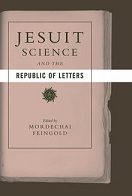 Article (book chapter)
Article (book chapter)- 28 pages
- Level: university
In this article William A. Wallace, O. P., takes his reader into the details of various manuscripts to document Galileo’s interactions with various Jesuits and their influence on him and his work. This article is a chapter in the 2003 book Jesuit Science and the Republic of Letters, edited by Mordechai Feingold and published by The MIT Press. Wallace concludes:
Admittedly this exposition of Galileo’s relationships with the Jesuits has been brief and sketchy, leaving many questions unanswered. But perhaps it serves to show that Galileo’s Jesuit connections were not insignificant, that they extended over a considerable period, and that in the long run they bore considerable fruit. To sum up: Galileo’s contacts with Clavius surely gave him his start, his borrowing from Vallius provided him with a sound logic of discovery and proof, and his polemics with later Jesuits pushed his genius to the extreme that was needed to found a new and modern science of mathematical physics.
Click here for an excerpt, courtesy of Google Books.
From the publisher, MIT Press:
Founded in 1540, the Society of Jesus was viewed for centuries as an impediment to the development of modern science. The Jesuit educational system was deemed conservative and antithetical to creative thought, while the Order and its members were blamed by Galileo, Descartes, and their disciples for virtually every proceeding against the new science. No wonder a consensus emerged that little reason existed for historians to take Jesuit science seriously. Only during the past two decades have scholars begun to question this received view of the Jesuit role in the Scientific Revolution, and this book contributes significantly to that reassessment. Focusing on the institutional setting of Jesuit science, the contributors take a new and broader look at the overall intellectual environment of the Collegio Romano and other Jesuit colleges to see how Jesuit scholars taught and worked, to examine the context of the Jesuit response to the new philosophies, and to chart the Jesuits’ scientific contributions. Their conclusions indicate that Jesuit practitioners were indeed instrumental in elevating the status of mathematics and in stressing the importance of experimental science; yet, at the same time, the Jesuits were members of a religious order with a clearly defined apostolic mission. Understanding both the contributions of Jesuit practitioners and the constraints under which they worked helps us to gain a clearer and more complete perspective on the emergence of the scientific worldview.
